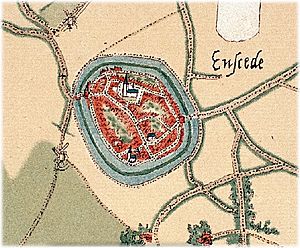Capture of Enschede (1597) facts for kids
Quick facts for kids Capture of Enschede (1597) |
|||||||
|---|---|---|---|---|---|---|---|
| Part of the Eighty Years' War and the Anglo–Spanish War | |||||||
 Plan of Enschede circa 1570 |
|||||||
|
|||||||
| Belligerents | |||||||
| Commanders and leaders | |||||||
| Strength | |||||||
| 6,700 infantry & cavalry | 120 | ||||||
| Casualties and losses | |||||||
| Unknown | All captured | ||||||
The capture of Enschede happened during two big wars: the Eighty Years' War and the Anglo–Spanish War. It took place on October 18 and 19, 1597. A combined army from the Dutch and England, led by Maurice of Orange, captured the city. They did this after a very short siege (when an army surrounds a city to make it surrender). Maurice's army threatened to destroy the city if it didn't give up. This event was part of Maurice's successful military campaign in 1597. The Dutch people called this period the Ten Glory Years because they won many battles against the Spanish.
The March to Enschede
After successfully capturing another city called Bredevoort, a part of Maurice's army moved towards Gronau. This group included soldiers from Scotland and Frisia, led by Count Solms and Van Duivenvoorde.
On October 18, Prince Maurice, along with his cousin William Louis, followed the cavalry (soldiers on horseback) and the artillery (cannons). These had been used at Bredevoort and were moved the day before. The main part of the army followed them. This included English troops led by Colonel Horace Vere and the Frisian soldiers. The companies of Duivenvoorde, Brederode, and the English cavalry formed the rearguard, protecting the back of the army.
How Enschede Was Captured
When the army was halfway to Enschede, at a place called Glanerbrug, Maurice ordered his soldiers to get ready for battle. They then marched towards the city. By this time, the cannons had arrived, so a proper siege could begin.
The army fired shots at the city walls for one day. After this, Maurice sent a trumpeter (a messenger) to the city gate. The trumpeter demanded that the city surrender. Maurice warned that if Enschede didn't give up, it would suffer the same terrible fate as Bredevoort and Groenlo. These cities had been burned and damaged during the chaos of an attack. Maurice threatened that he would "break the heads of them all if he fired a single shot with the artillery." This was a strong warning to make them surrender quickly.
The governor of Enschede, Lieutenant Grootveld, and the commander of the soldiers inside, Captain Vasques, asked if they could see the powerful cannons threatening the city. Maurice agreed to this. After they saw the artillery and talked with the city's religious leaders, they decided to accept Maurice's terms. They called his conditions "absolutely fair."
The Spanish soldiers, about 108 men in two groups, then marched out of the city. A group of Dutch soldiers then took control of Enschede. Their commander, Jaques Meurs, became the new governor. Maurice ordered that the city's defenses be mostly taken apart. This was to make sure Enschede couldn't be used easily by other armies in the future. After securing Enschede, Maurice's army marched to the city of Oldenzaal and captured it after another short siege. A group of Dutch and English soldiers, led by Captain Van Duivenvoorde, went in a different direction. They headed northeast to capture Ootmarsum.
See also
- List of stadtholders in the Low Countries
- List of governors of the Spanish Netherlands
- Siege of Bredevoort (1597)
- Siege of Groenlo (1597)


